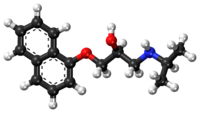
Photo from wikipedia
Anesthetic failure is common in dental inflammation processes, even when modern agents, such as articaine, are used. Nanostructured lipid carriers (NLC) are systems with the potential to improve anesthetic efficacy,… Click to show full abstract
Anesthetic failure is common in dental inflammation processes, even when modern agents, such as articaine, are used. Nanostructured lipid carriers (NLC) are systems with the potential to improve anesthetic efficacy, in which active excipients can provide desirable properties, such as anti-inflammatory. Coupling factorial design (FD) for in vitro formulation development with in vivo zebrafish tests, six different NLC formulations, composed of synthetic (cetyl palmitate/triglycerides) or natural (avocado butter/olive oil/copaiba oil) lipids were evaluated for loading articaine. The formulations selected by FD were physicochemically characterized, tested for shelf stability and in vitro release kinetics and had their in vivo effect (anti-inflammatory and anesthetic effect) screened in zebrafish. The optimized NLC formulation composed of avocado butter, copaiba oil, Tween 80 and 2% articaine showed adequate physicochemical properties (size = 217.7 ± 0.8 nm, PDI = 0.174 ± 0.004, zeta potential = − 40.2 ± 1.1 mV, %EE = 70.6 ± 1.8) and exhibited anti-inflammatory activity. The anesthetic effect on touch reaction and heart rate of zebrafish was improved to 100 and 60%, respectively, in comparison to free articaine. The combined FD/zebrafish approach was very effective to reveal the best articaine-in-NLC formulation, aiming the control of pain at inflamed tissues.
Journal Title: Scientific Reports
Year Published: 2020
Link to full text (if available)
Share on Social Media: Sign Up to like & get
recommendations!